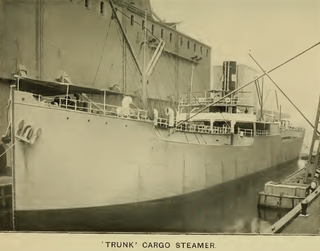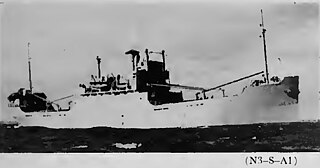
The Victory ship was a class of cargo ship produced in large numbers by North American shipyards during World War II to replace losses caused by German submarines. They were a more modern design compared to the earlier Liberty ship, were slightly larger and had more powerful steam turbine engines giving higher speed to allow participation in high speed convoys and make them more difficult targets for German U-boats. A total of 531 Victory ships were built.

A bulk carrier,bulk freighter, or colloquially, bulker is a merchant ship specially designed to transport unpackaged bulk cargo, such as grains, coal, ore, and cement, in its cargo holds. Since the first specialized bulk carrier was built in 1852, economic forces have led to continued development of these ships, resulting in increased size and sophistication. Today's bulk carriers are specially designed to maximize capacity, safety, efficiency, and durability.
Bremer Vulkan AG was a prominent German shipbuilding company located at the Weser river in Bremen-Vegesack. It was founded in 1893 and closed in 1997 because of financial problems and mismanagement.
Type C1 was a designation for small cargo ships built for the U.S. Maritime Commission before and during World War II. The first C1 types were the smallest of the three original Maritime Commission designs, meant for shorter routes where high speed and capacity were less important. Only a handful were delivered prior to Pearl Harbor. But many C1-A and C1-B ships were already in the works and were delivered during 1942. Many were converted to military purposes including troop-transports during the war.
William Doxford & Sons Ltd, often referred to simply as Doxford, was a British shipbuilding and marine engineering company.

A trunk deck ship is a type of merchant ship with a hull that was stepped inward in order to obtain more favourable treatment under canal toll rules then in effect. As those tolls were set by net tonnage, a measure of volume, and as the tonnage rules did not account for all of the cargo space of such vessels, trunk deck ships incurred lower tolls than more conventional ships of equivalent capacity. When the measurement rules were changed, the type was no longer built.
A CHANT was a type of prefabricated coastal tanker which was built in the United Kingdom during the Second World War due to a perceived need for coastal tankers after the invasion of France. Some CHANTs were adapted to carry dry cargos. These were known as the Empire F type coasters.

Empire Chaucer was a 5,970 GRT cargo ship which was built in 1942 by William Pickersgill & Sons Ltd, Sunderland. She was built for the Ministry of War Transport (MoWT). Completed in May 1942, she had a short career, being torpedoed and sunk by U-504 on 17 October 1942.

Type N3-S ships were a Maritime Commission small coastal cargo ship design to meet urgent World War II shipping needs, with the first of the 109 N3, both steam and diesel, type hulls delivered in December 1942.
London & Overseas Freighters Ltd. (LOF) was an ocean-going merchant shipping company that for most of its history was based in the United Kingdom.

The MV Murree was a 1981 ship of the SD18 type, which sank in the English Channel in 1989.
SS Gasfire was a British steam collier of the Gas Light and Coke Company (GLCC). She was built in Sunderland in 1936, survived severe damage from being torpedoed in 1940 and was sunk by a mine in the North Sea in 1941.

Lizzonia was a 401 GRT Empire F type coaster that was built in 1944 by Goole Shipbuilding & Repairing Ltd, Goole, United Kingdom as Empire Farouche for the Ministry of War Transport (MoWT). In 1946, she was sold and renamed Lizzonia. She was re-engined in 1956 and sank in 1961 following a collision with another vessel.
Bulgaria was a 4,191 GRT cargo ship that was built as Empire Flamborough in 1945 by William Pickersgill & Sons Ltd, Sunderland, County Durham, United Kingdom for the Ministry of Transport (MoT). She was sold to Norway in 1946 and renamed Vindeggen. A further sale to Bulgaria in 1948 saw her renamed Bulgaria. She served until 1976 when she was scrapped.
Adele was a Swiss cargo ship, later the merchant ship Sunadele. Initiated by Gottlieb Duttweiler and named after Adele Duttweiler, she served in the Merchant Marine of Switzerland.

The Leninsky Komsomol class (also transliterated as Leninskiy Komsomol or Leninskij Komsomol was a class of 25 ocean-going dry cargo ships; tweendeckers with turbine main engines, built between 1959 and 1968 in the Soviet Union under the designations Projects 567 and 567K. Twenty were built by the Kherson Shipyard, and five in either the Nikolayev Shipyard, or the Nosenko Shipyard in Nikolayev. They were part of a program to modernize the Soviet Union's merchant fleet.
Solstad was a steam cargo ship built in 1916 by the Sunderland Shipbuilding Company of Sunderland for A. F. Klaveness & Co of Kristiania. She was primarily employed as a collier doing tramp trade during her career.
















